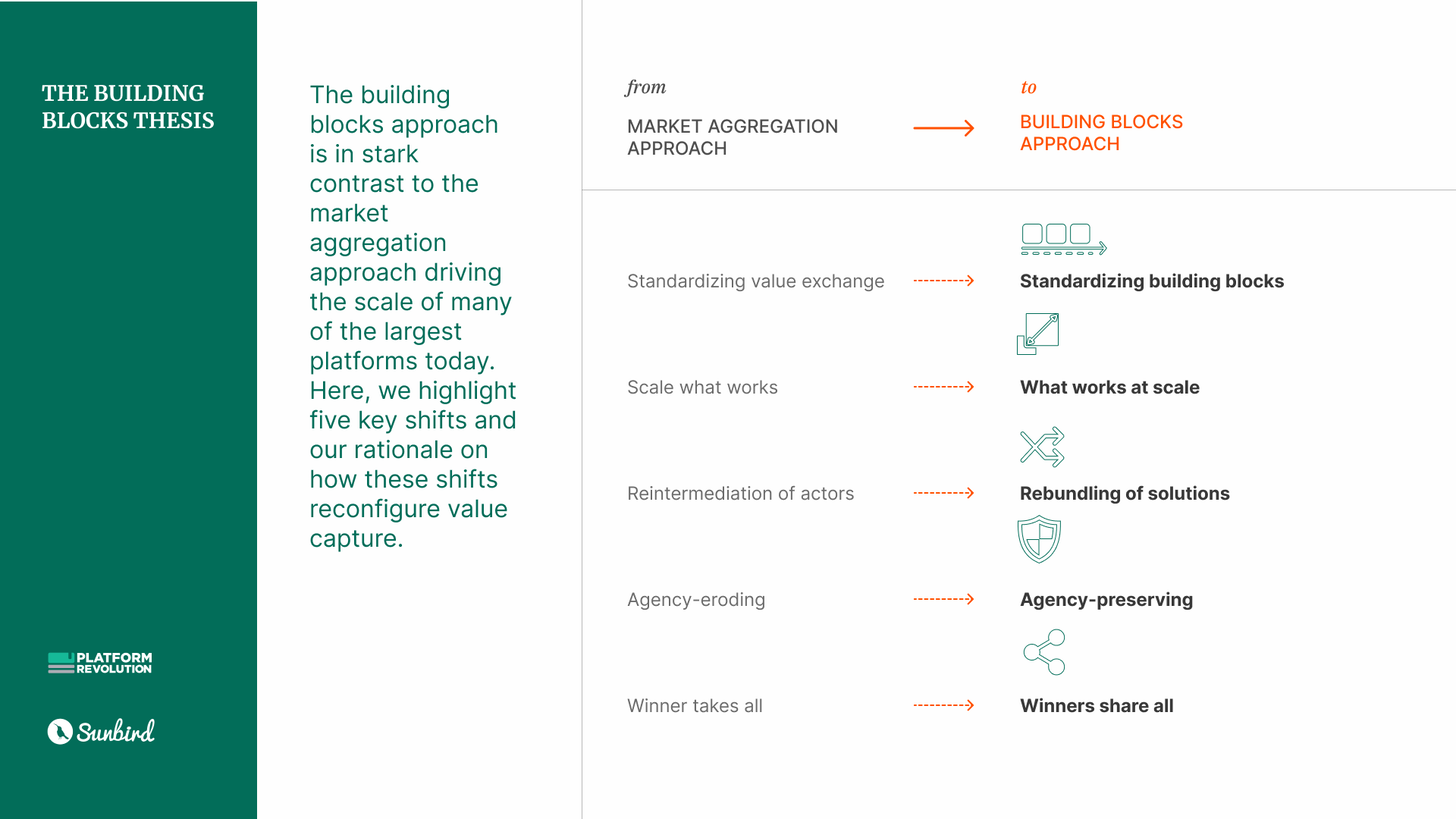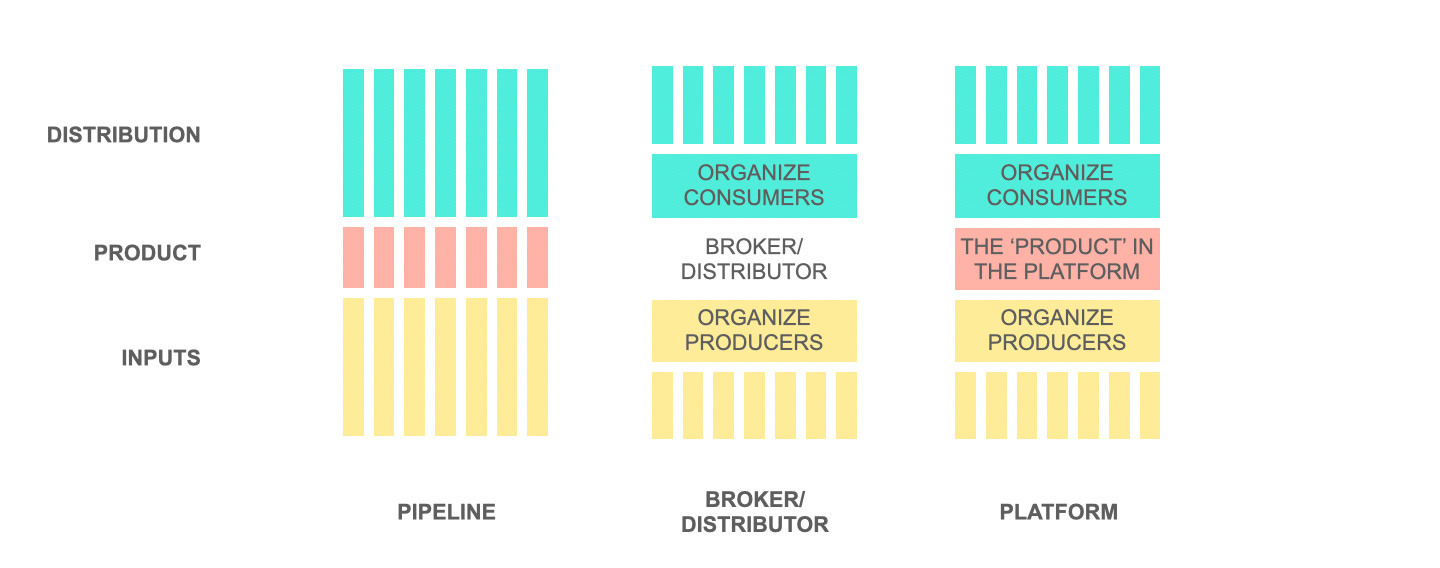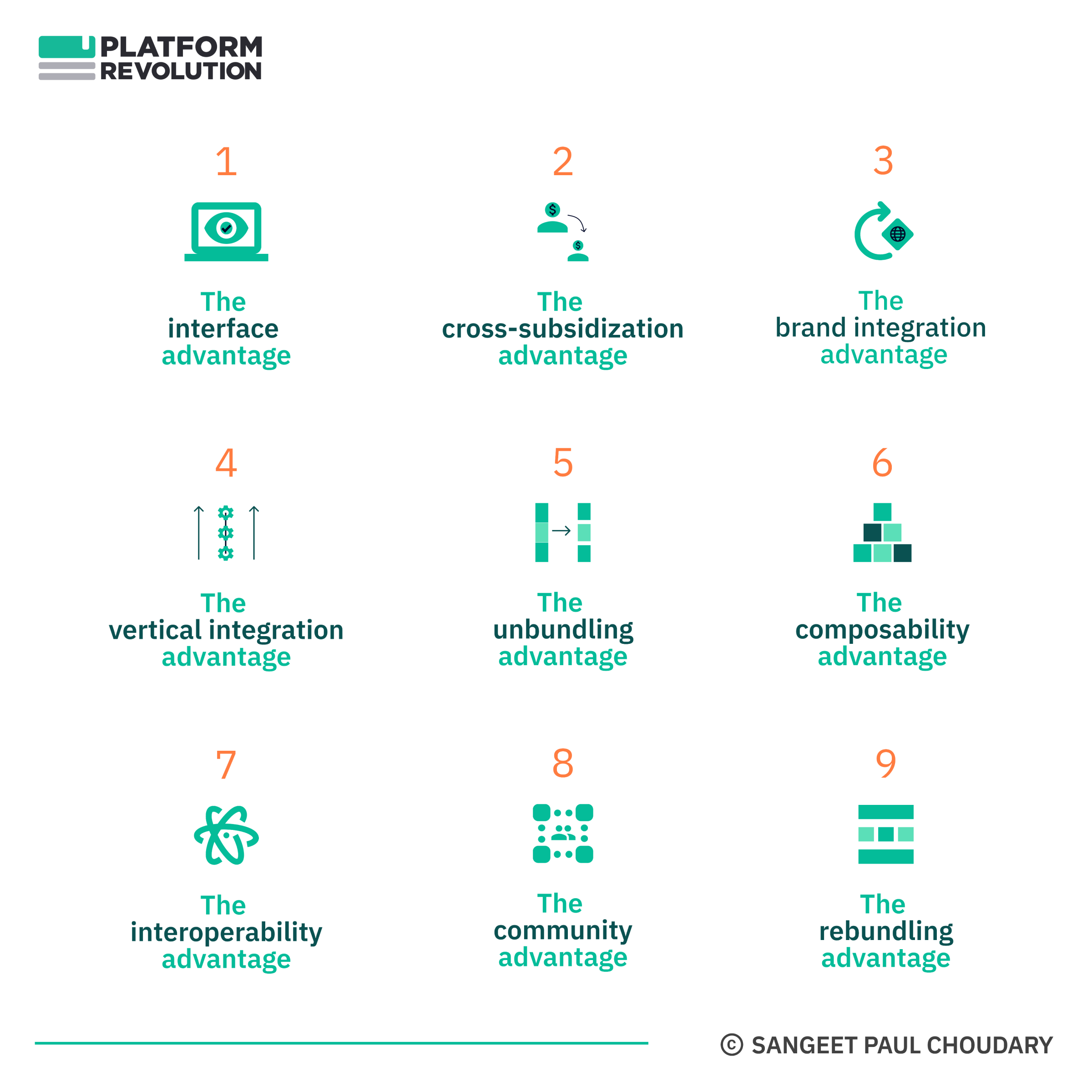Strategy
The five shifts of decentralization
The largest businesses today – Facebook, Google, Amazon, Apple, Airbnb, and others – aggregate entire markets of activity and scale through network effects. By aggregating demand and standardizing the mechanism of value exchange, these businesses achieve scale.
Market aggregation has emerged as the dominant mechanism to achieve scale in solving user problems and scaling business models. Scale in market aggregation – built through provisioning market infrastructure (e.g. Amazon, Airbnb) and/or information services (e.g. Google, Facebook) – enables these businesses to standardize market transactions and drive scale efficiencies across diverse and fragmented markets. Commoditizing and standardizing the value exchange between end market participants enables these firms to scale solutions across diverse contexts.
But the challenges inherent to this approach to problem solving are increasingly becoming evident as centralized platforms reveal the dark side of the platform economy.
We believe there is a better approach to leveraging the power of the platform economy: the building blocks approach.
In volume one of this thesis, we introduced the building blocks approach as a new paradigm for value creation.
In volume two, we explained how solution builders should think about adopting the building blocks approach.
In this third and final volume, we call out five key shifts that the platform economy will make as we move from centralized, extractive platforms to composable building blocks.
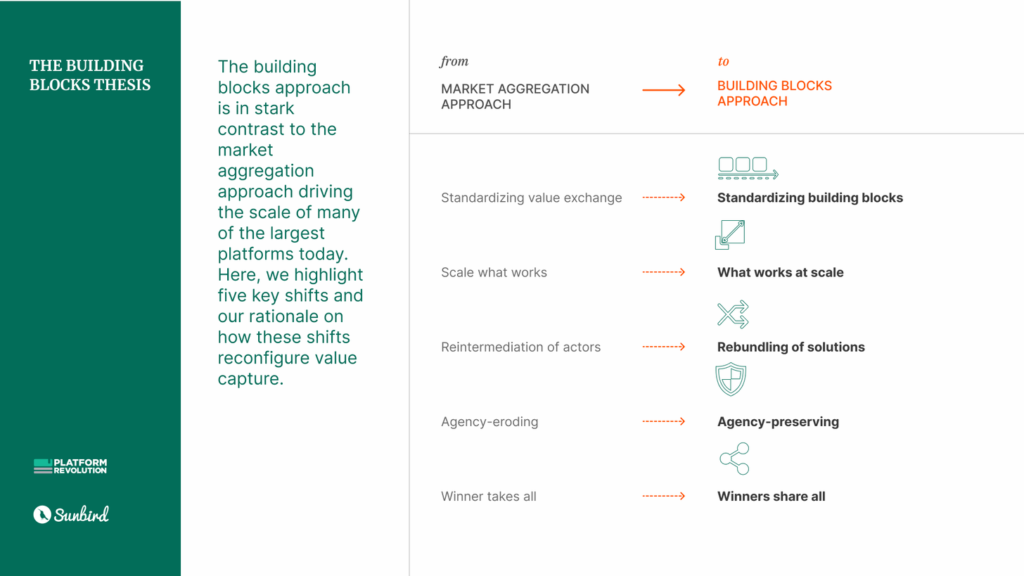
The problems with centralized platforms
The challenges posed by centralized platforms emerge because of
(1) loss of context through standardization and ‘central planning’ and
(2) concentration of power through centralization.
Second, this issue is further exacerbated in markets that require not merely transactions but context-rich interactions. Consider the market for primary education where students engage in learning experiences. Standardization of education delivery – a common approach followed by today’s EdTech platforms – sacrifices the context required to deliver an enriching experience to the student.
Standardization at scale leads to a second challenge. Platforms leverage their scale and consequent market power to increasingly commodify and disempower platform users. Consider ride-hailing and delivery applications where the service provider is fully commodified and perfectly substitutable by another service provider. Commodification is also observed in the competition for the Amazon Buy Box where sellers engage in competitive bidding, often eroding margins, to achieve the default position on the Buy Box. Further, platforms often lock-in their users through bait and switch tactics, employing policy changes after users (typically producers) have invested significant resources into building their business on the platform. Developers on Twitter and brands building fan following on Facebook Pages learnt this the hard way when the respective platforms changed their policies, impacting the market reach and available functionality for these businesses building on the platforms.
Third, this disempowerment enables platforms to increasingly extract value from the ecosystem. While most platforms start off with policies benevolent to the ecosystem, they increasingly shift to policies that centralize and concentrate power with them. Essentially, platforms that scale through market aggregation and standardization often radiate risks to the ecosystem while centralizing rewards. In a statement to Congress, Amazon has publicly stated that it uses aggregated third party data from its marketplace to inform its private label brands. Moreover, Amazon directly out-competes the most successful brands in its ecosystem after these brands prove out the market (taking on the startup risk to do so). Research conducted by Feng Zhu and Qihong Liu published in Strategic Management Review in 2018 studied 164,000 products sold by merchants on Amazon’s platform. Data collected over a period of 10 months revealed that Amazon had started directly selling more than 5000 of these products despite not having sold them at the beginning of the study. The research also demonstrated that alternatives offered by Amazon were often the default option associated with the Buy box, over those sold by other merchants.
Finally, the factors above work together to drive concentration of an inordinate amount of wealth in the hands of a few. Wealth distribution is skewed towards platform owners and sponsors – those operating ‘above’ the algorithm – and skewed away from platform participants – those typically operating ‘below’ the algorithm.
Here’s a quick summary of the dark side of centralized platforms:
For much of the past decade, we’ve accepted these issues as an acceptable trade-off to benefit from the improved user experience, convenience, transaction safeguards, and choice that digital platforms bring to fragmented and unorganized markets.
But the benefits of market efficiency cannot justify the disempowerment of the ecosystem, or the concentration of power and wealth with a few.
Since the late 2010s, and accelerated further through the pandemic, escalating regulatory action and increasing investments in blockchain-based decentralized solutions demonstrate the growing angst with the platform domination narrative.
We believe the building blocks approach provides a solution to this problem.
It shifts the locus of solutioning away from a monopolistic and standardized solution to consumer problems and towards empowering the rest of the ecosystem to better solve for consumers.
In part one of this three-part series, we explained the idea of building blocks and how the value creation logic of a building blocks approach is fundamentally different from that of market aggregation.
As explained in part one:
Digital building blocks enable solution design at ecosystem scale. A digital building block leverages digital technologies, enabling greater flexibility in solution design. Digital building blocks are autonomous and hence perform specific tasks and functions independently. But by defining standards and specifications, these building blocks may be recombined towards solution design allowing interoperability between building blocks as well as interoperability between higher end solutions designed using these building blocks. Effectively, digital building blocks enable a ‘system of solutions’ that can plug-and-play across each other, enabling a vast and seemingly unconnected ecosystem of solution creators to more effectively coordinate their efforts towards solving large-scale problems through diverse context-rich solutions.
Since the late 2010s, and accelerated further through the pandemic, escalating regulatory action and increasing investments in blockchain-based decentralized solutions demonstrate the growing angst with the platform domination narrative. We believe the building blocks approach provides a solution to this problem.
Feel Free to Share
Download
Our Insights Pack!
- Get more insights into how companies apply platform strategies
- Get early access to implementation criteria
- Get the latest on macro trends and practical frameworks
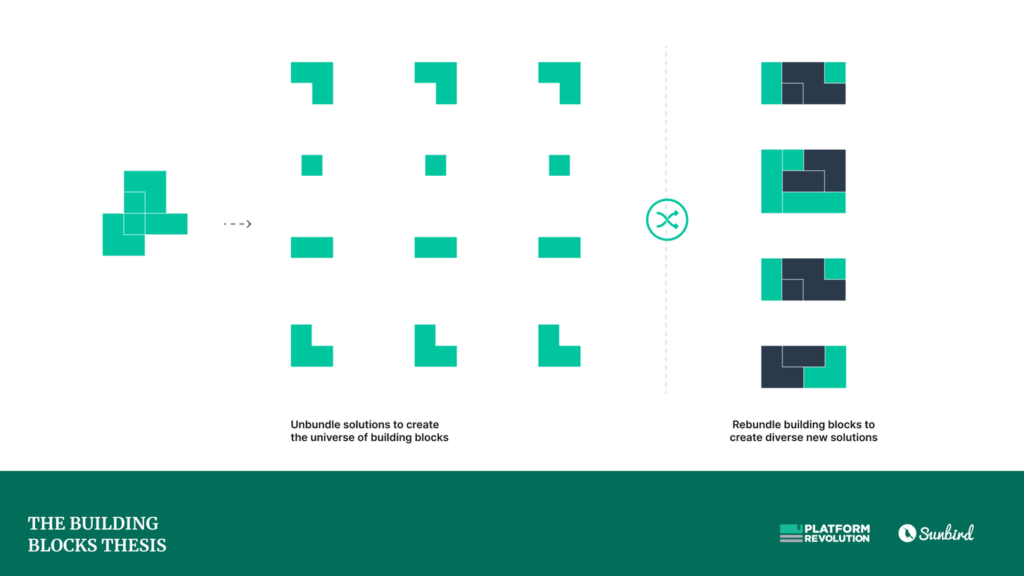
In volumes one and two of this three-part series, we discussed the power of a building blocks approach in redesigning value creation. Here, we lay out the power of a building blocks approach in redesigning value capture and in redistributing value back to the ecosystem.
The building blocks approach is in stark contrast to the market aggregation approach driving the scale of many of the largest platforms today. Below, we highlight five key shifts and our rationale on how these shifts reconfigure value capture.
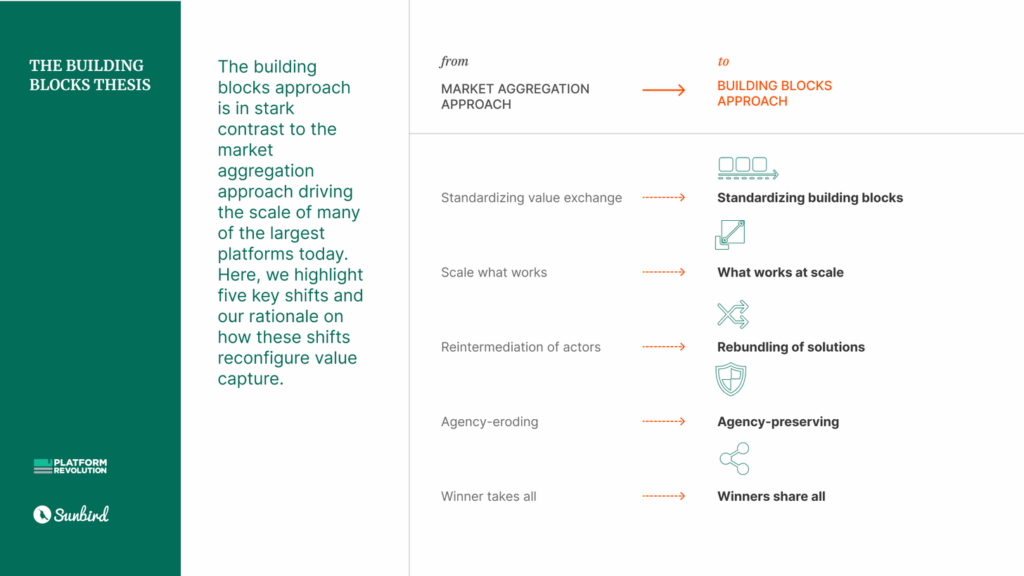
1. FROM STANDARDIZING VALUE EXCHANGE TO STANDARDIZING BUILDING BLOCKS
Most platforms that seek to achieve scale through market aggregation do so by standardizing a solution for value exchange (e.g. creating a one-size fits all marketplace). Instead, a building block approach seeks to achieve scale by enabling coordination across diverse ecosystem actors, leveraging standardized solution constituents.
This is especially important when value exchange between stakeholders cannot be fully modeled as commoditized transactions. Certain use cases are relationship-dominant, where stakeholders value mutual trust, empathy, and investment in a common plan of action. For such use cases, solutions must be designed to best leverage the trust, empathy, and investment already inherent to the relationship.
For instance, while the delivery of a package by delivery agents may be fully standardized and scaled through technology, the relationship between a teacher and a student should be empowered within their context instead of being scaled with a one-size-fits-all approach, through standardization.
To clarify, standardization in solution design does not imply a lack of personalization. Most market aggregation platforms leverage standardized solution design but personalize user experience through recommendation engines and personalized feeds. However, the personalized experience is delivered within the construct of a standardized solution – a solution that assumes one standardized approach across the entire market, independent of individual delivery contexts.
Personalized learning is one such example. A learning platform for school children may employ standardized delivery to deploy personalized content to each learner based on codified learner inputs (e.g. learner interactions with digital content). However, despite this personalization, the platform would still lack the non-codified context within which the learner learns, including the social, emotional and physical learning context. This context is best preserved by empowering stakeholders involved in last mile delivery of the learning experience.
A building blocks approach allows the ecosystem to build context-specific solutions (which preserve individual context) while leveraging standardized solution components (building blocks). Solutions as well as the attendant user experience are deeply contextual while common solution components provide standardization and interoperability. A teacher who uses an assessment solution, as a building block, to measure progress of children in class is able to connect the child’s progress or lack of it to other possible factors beyond delivery of content like social, physical, mental, emotional or even nutritional issues which might be at play.
Further reading: Standardizing building blocks
2. FROM SCALE WHAT WORKS TO WHAT WORKS AT SCALE
Second, market aggregation platforms achieve scale by scaling what works. Learning from an initial customer set (early adopters), they standardize the solution and scale it across the market.
Instead, a building blocks approach is more focused on building what works at scale. A building blocks approach starts with the universe of possible solutions and determines the common fundamental elements that constitute such solutions. It then goes about standardizing these fundamental elements with an aim to enable cross-leverage and reuse of these ‘building blocks’ across diverse solution contexts. It then engages an ecosystem of actors who use these building blocks to deploy solutions across varied contexts.
Essentially, the ‘Scale what works’ approach standardizes the end to end value exchange while the ‘What works at scale’ approach standardizes the context-agnostic building blocks needed to create and deliver solutions across different contexts and engages an ecosystem of actors to build out those solutions.
3. FROM REINTERMEDIATION OF ACTORS TO REBUNDLING OF SOLUTIONS
A third and important distinction lies in the mechanism of value creation.
Most market aggregation platforms create value by disintermediating inefficient gatekeepers, aggregating the market, and re-intermediating market interactions efficiently.
A building blocks approach doesn’t re-intermediate the value chain, thereby displacing value chain stakeholders. Instead, it empowers stakeholders across the value chain – even those who may have performed inefficient gatekeeping roles – and removes bottlenecks to value creation through empowerment, instead of through disintermediation. Stakeholders across the value chain can create new and more effective solution bundles by rebundling building blocks within their context.
A common approach among Edtech platforms looking to scale online education is to disintermediate traditional schools and teachers and re-intermediate the delivery of learning experiences to learners. In this approach, bottlenecks related to teacher capacity and capability are eliminated and technology provides an alternate scalable delivery mechanism.
Instead, a building blocks approach works towards a systemic solution where teachers are empowered (and their capacities and capabilities scaled up) with technology-based solutions to operate within their context.
4. FROM AGENCY-ERODING TO AGENCY-PRESERVING
With this inversion in solution design, there is an inversion in power dynamics.
Market aggregation and reintermediation are agency-eroding and often disempower other stakeholders in the ecosystem, as illustrated with the examples of Uber and Amazon further up.
A building blocks approach, on the other hand, is agency-preserving. It empowers stakeholders to better operate within their context and leveraging their unique abilities, while benefiting from a larger system of underlying solutions.
The rise of web3 is another example of an ecosystem of actors leveraging the building blocks approach to redistribute power. As players create applications around a protocol, value accrues to the protocol and benefits all applications (through tokenomics) instead of being concentrated with any specific application.
Further reading: Platforms and agency
5. FROM WINNER TAKES ALL TO WINNERS SHARE ALL
Finally, market aggregation platforms are often associated with ‘winner-takes-all’ dynamics where a single firm concentrates market value and captures most of this value.
Instead, building blocks when deployed as public goods, as with Sunbird, enable shared ownership of solutioning infrastructure, leading to a ‘winners-share-all’ dynamic. As the ecosystem builds new building blocks, all participants benefit through reuse and cross-leverage. Essentially, the entire lego set wins, not the builder or the sponsor alone.
The five shifts above illustrate the relevance of the building blocks approach in solving problems that are not well addressed through market aggregation. We believe that problems that benefit from standardization of transactions at scale – for instance, ride-hailing – will continue to benefit best from a market aggregation approach. However, problems which require local context in solutioning are best addressed by empowering and enabling the ecosystem, best achieved through a building blocks approach.
Further reading: Winners share all
The future will be built… block by building block
The building blocks approach will herald a new era of openness – one that unlocks value beyond today’s platform economy, and one in which design, deployment, and capture of value is decentralized across a larger ecosystem of players and an ever-increasing library of building blocks.
A building blocks approach may be applied to any ecosystem. The rise of token-backed protocols presents an alternative to organizing ecosystems where the ecosystem itself creates the building blocks of value creation around the protocol. Public digital infrastructures like the India Stack and the ONDC (Open Network for Digital Commerce) also demonstrate the potential of open, modular ecosystem development using a building blocks approach.
Building blocks dismiss the false trade-off of scale vs agency, and demonstrate that scale may be achieved while simultaneously empowering ecosystem players and redistributing value across them.
The Building Blocks Thesis — Deep-Dive
This series is co-authored with Shankar Maruwada, CEO and co-founder of the EkStep Foundation. I am an advisor to the EkStep Foundation.
To learn more, visit www.sunbird.org and www.platformthinkinglabs.com.
You may also write to [email protected] or [email protected].
State of the Platform Revolution
The State of the Platform Revolution report covers the key themes in the platform economy in the aftermath of the Covid-19 pandemic.
This annual report, based on Sangeet’s international best-selling book Platform Revolution, highlights the key themes shaping the future of value creation and power structures in the platform economy.
Themes covered in this report have been presented at multiple Fortune 500 board meetings, C-level conclaves, international summits, and policy roundtables.
Subscribe to Our Newsletter



